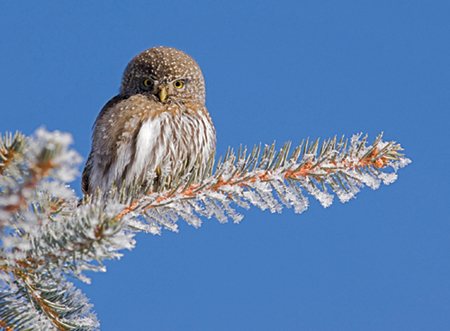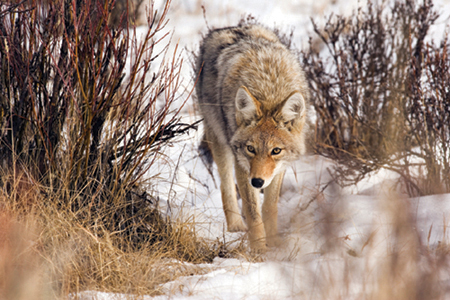The Excitement Over Digital Photography
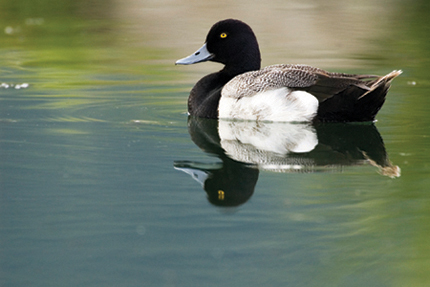
Lesser scaup are diving ducks that spend time “dating” on our small farm pond every May and June. Since the pond is often ripple free at dawn, we can capture images with a pleasing mirror reflection.
FOLLOWING PAGES: A clear and calm January afternoon was the perfect time to photograph Midway Geyser Basin with three separate images that were stitched together manually.
Digital photography is generating excitement in the world of nature photography unlike anything else in my long career. I have always cared dearly about obtaining quality images. As a result, I missed the early stages of the digital revolution because it didn’t make any sense to buy cameras that were far more expensive than top of the line film cameras, only to get inferior results. But, by 2003, the best digital cameras were coming close to the quality offered by the best slide films. Perhaps they weren’t quite as good as Fuji Velvia 50 slide film, but digital capture was excellent and becoming widely accepted by photo buyers. When the 16.7-megapixel Canon 1Ds Mark II became available a year later, digital capture was at least as good as slide film and more fun too.
The new tools offered by digital such as being able to change the ISO from one shot to the next, changing white balance to match the light conditions, and shooting panoramics and stitching the images together with software, have tremendously affected the way nature photographers shoot in the field. Students shooting digital learn much faster. The instant feedback offered by digital capture makes it so easy to fix exposure, white balance, composition, or focusing mistakes in the field while the subject is still present. That’s a huge advantage!
WHY TAKE NATURE PHOTOGRAPHS?
We all have reasons for photographing nature. Perhaps you are more interested in winning a photo contest at the State fair or camera club. Perhaps you want to get published in a calendar, magazine, or book. Perhaps you want a beautiful web site or gorgeous prints on the wall. Perhaps you love digital cameras and computers so you make images to use those tools. Perhaps you love being in natural places and making photos gives you an excuse to spend time enjoying natural events. You may photograph for fun or hope to make some money from your images. All of these are valid reasons to photograph nature. Most likely your reasons for taking photographs of nature include a combination of these.
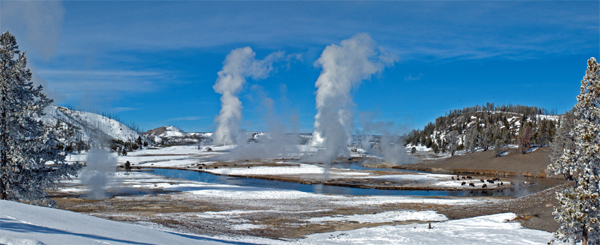
GREAT PLACES TO TAKE NATURE PHOTOGRAPHS
One of the wonderful things about nature photography is that it can be done anywhere. You don’t need to travel the world to take nature photographs. Even if you live in a large city, natural areas are nearby. New York City has Central Park, plus zoos and botanical gardens. Let’s start with your own property. If your entire property is a mowed lawn, perhaps you could plant a flower garden. Then you would have many opportunities to photograph flowers and the insects that are attracted to them. Bird feeders and water baths should attract a large variety of colorful songbirds. Any nearby meadow full of wildflowers is certain to be packed with photogenic subjects, especially on a cool dewy morning. Nearby forests, lakes, marshes, and seashores offer many opportunities for the nature photographer. In many locations, public land is available to use.
I grew up in Lapeer County, a rural county 60 miles North of Detroit. While most of the county was private land, gaining permission to photograph on private property was easy to get. State parks were available too and I spent many hours at Seven Ponds Nature Center photographing the wildflowers in their restored prairie. I did most of my nature photography in the Lapeer State Game Area, a huge block of wild land that was purchased by hunters and fishermen to keep it wild. I found so many different subjects to photograph that I could have spent my entire life photographing in Lapeer County without ever running out of new subjects to photograph.

Dewy meadows are certain to harbor numerous adorable subjects like this Common St. Johnswort that supports a delicate spider web loaded with dewdrops.
TREAD LIGHTLY ON THE LAND
It’s important to respect your subject and it’s environment. Try to impact the natural world as little as you can. It is not possible to have no impact, but your impact can be minimized. Avoid damaging your subjects. Don’t pick wildflowers. Try to stay on trails or bare areas to avoid stepping on delicate flowers. Don’t harass wildlife. I like to photograph wild orchids for example. While all of us would avoid damaging the orchids we can see in bloom, it’s important to recognize the orchids that haven’t yet bloomed so they won’t be crushed. I usually photograph a couple of nesting birds near my home each year. I always pick the easiest nests with birds that are fairly habituated to me already. The number of mountain bluebirds that nest on our property varies from 5 pair to 7 pairs-depending on the year. Some mountain bluebirds wouldn’t allow me to approach closely, but one pair readily ate meal worms out of my hand so that was the pair to photograph. A wide assortment of woodpeckers nest near my property and they are always easy to photograph. On the other hand, a pair of northern goshawks nest a few hundred yards behind my home in the dense lodgepole forest. They are skittish birds that are prone to abandoning their nest if bothered by humans so it is too risky to try to photograph them.
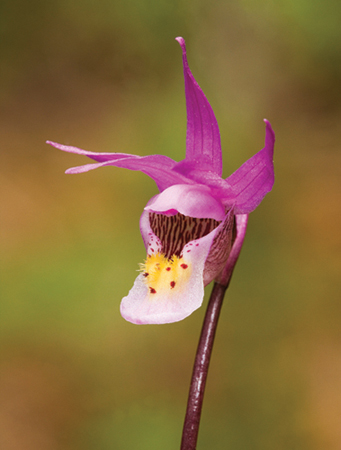
Calypso orchids are common wildflowers that bloom around the Fourth of July near our Idaho home. This blossom was isolated from the background with a 200mm macro lens.
It helps to have a wildlife friendly yard. Several pairs of mountain bluebirds nest in our wooden nest boxes every June.
It’s wise to use the best techniques possible to get the finest image quality. If your goal is super images, then never cut corners when it comes to technique. One serious drawback to digital technology is some folks are becoming sloppy in their technique because they think problems can be fixed with software. While software capabilities are truly amazing, they can’t fix everything. Out-of-focus images are still out-of-focus no matter what you do. Grossly overexposed images don’t improve much with software either.
Images that require a lot of help from software are probably not very good to begin with. My goal and I hope your goal is to shoot the finest possible image in the field. Any image that requires few adjustments with image-editing software is the image you should be striving for while shooting in the field. It’s been said many times before and bears repeating, “Garbage in, garbage out”.
I stress producing high-quality images throughout this book. I don’t cut any corners while emphasizing those critical techniques that produce wonderful and technically sound images time after time. Anyone can learn to take excellent images, but it does require that you master technique. It just requires practice and time to succeed.
USE EXCELLENT EQUIPMENT
Buying good camera equipment is important to your success. You certainly don’t need the latest and greatest top of the line camera to succeed. I tend to have a lot of equipment because I am always trying to find better ways to make quality images. However, I am not an equipment junkie and I struggle to learn new camera gear just like you do. Equipment that is suitable for nature photography is a real joy to use so it’s important to get the features you need. In many cases, I will tell you exactly what equipment I use and why, but also suggest other possibilities that might be less expensive or easier for you to carry in the field.
DEVELOP EXCELLENT SHOOTING HABITS
You’ll find that whatever camera system you use, it changes rapidly over time. This is even more true today because of the rapid advances in digital technology. You’ll be continuously tempted by the latest and greatest cameras and lenses. But, no camera has ever taken a great picture all by itself so don’t depend too much on the equipment. Developing excellent shooting habits that consistently produce quality is the key to becoming a really good nature photographer. Using a tripod whenever possible, finding photogenic subjects, using light well, focusing carefully, composing thoughtfully, and selecting creative angles are all critical to creating outstanding images. While equipment changes rapidly during your photographic journey, the creative side of photography does not evolve nearly as fast, so don’t focus so much on equipment that you neglect the artistic side of nature photography which is more important than cameras and lenses.
BECOME A BETTER NATURALIST
The more you know about nature, the better your images. You don’t need a degree in biology to become an excellent naturalist. Many of the best birders or wildflower lovers are self-taught. Many field guides are available today on very specific subjects. When I started out, you could buy a field guide to the birds of the Eastern US and another to the Western US. Now most states have their own field guides which are far more precise and detailed than general guides. There are even field guides on specific groups of birds such as hummingbirds, hawks and owls, and waterfowl. Many nature centers, local colleges, and parks offer field classes on natural history subjects. These are all worth taking to broaden your knowledge of nature. The more you know about nature, the more you’ll enjoy your time in the outdoors and the more you’ll find to photograph. The best nature photographers tend to be knowledgeable naturalists so learn more about nature right along with learning about digital photography.
This Northern Pygmy Owl is a fierce diurnal hunter of small birds. It frequently patrols our bird feeder hoping to find an inattentive visitor.
PROFESSIONAL VS. AMATEUR NATURE PHOTOGRAPHERS
Are professional nature photographers better than amateurs? I know quite a few professional nature photographers and some are better than most amateurs and some aren’t. Saying you are a professional photographer means you make the majority of your money from photography. Amateurs make his/her money in some other way. Identifying yourself as an amateur or pro nature photographer really says nothing about your knowledge or skill level. It merely indicates your source of income. One of the finest nature photographers I know who easily would occupy a slot in my top 10 list of nature photographers is Alan Charnley. You haven’t heard of Alan because he doesn’t try to sell photos or make any money from his nature photography. He has been my dentist for the past 30 years. Incredibly successful in his practice, he doesn’t need or want to bother with making money from nature photography. He does it strictly for the fun of it. Plenty of amateur nature photographers like Alan are every bit as good as the professionals. Everyone can be an excellent nature photographer if they apply themselves and spend enough time in the field finding wonderful subjects to photograph.
THE THREE FACTORS THAT MAKE A WONDERFUL NATURE IMAGE
Over the past three decades, I have examined thousands of nature images produced by my students, other photographers, and myself. All of the really outstanding images I see exhibit three characteristics. While I don’t want producing excellent nature images to boil down to a formula, there are three keys to consistently making rewarding images. These factors include using excellent technique to capture a photogenic subject in a wonderful situation. You need all three, subject, technique, and situation to make stunning images time after time. If any one of these is missing, the resulting picture usually becomes just another image. Let’s look at each of the three factors in detail.
Technique is the first priority for beginning nature photographers. You want to shoot properly exposed, well composed, and sharp images. It is important to learn to use your equipment to extract the greatest sharpness your camera gear can deliver by using the best optics, filters, and tripods to make sharpness a certainty. Take the time to master exposure. You must fully understand f-stops and shutter speeds, ISO values, metering patterns, histograms, highlight alerts, and compensation dials for flash and natural light. While technique is critical to success, don’t become so obsessed about it that you are oblivious to the other factors that make a successful image.
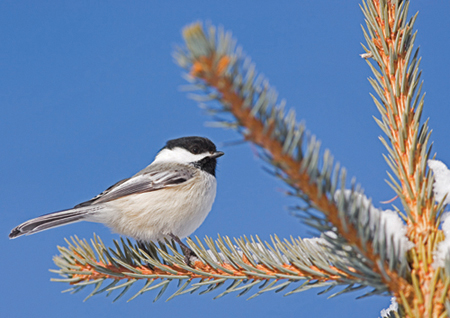
Black-capped chickadees are abundant at our winter feeding stations. They are so fast that we handhold 300 mm lenses that have image-stabilization, push up the ISO to at least 200, and shoot around f/5.6 to maintain high shutter speed for sharp images.
Subject selection is just as important as technique though. Photographing a chickadee in late summer is certain to be an unattractive photo no matter how sharp and well exposed the image. These birds molt during late summer so they are missing many feathers making them unattractive. It is much better to photograph chickadees in late fall to mid-spring when they are fully feathered. Most nature subjects have periods of time when they are more photogenic than others. Wildflowers are excellent examples. Some blossoms are more pleasing to view than others. In a wildflower meadow, search for the best blossoms to photograph. There is no point in photographing a blossom that is beginning to wilt when other blossoms are in peak condition. In Northern Michigan, meadows are typically soaked with dew following cool, clear nights. Some meadows bordering lakes are full of roosting dragonflies and grasshoppers that are bejeweled with dew. By searching the meadow in predawn light, find as many sleeping dragonflies as possible. In a half hour, you might find 15–30 dew-laden dragonflies and a couple of butterflies. Don’t photograph everything you find, but work only the most outstanding specimens. Rather than taking a few images of 30 different subjects, carefully select the most photogenic and take dozens of images of the very best. Selecting the subjects that offer the most promise is crucial to success. Avoid wasting time in photographing unexciting subjects. Find the best opportunities and work them thoroughly!

In a meadow full of wildflowers, always look for the very best blossoms such as these Lewis’s monkey flowers.
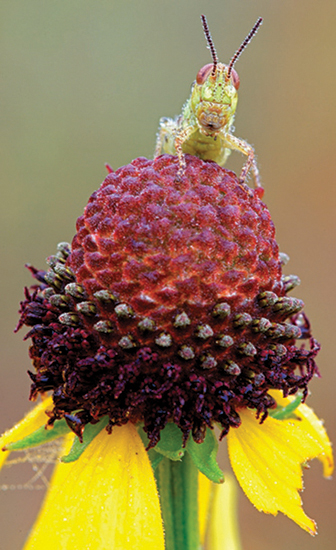
This tiny grasshopper has spent the night perched on this gray-headed coneflower.
The situation is critical too. A male lesser scaup in spring breeding plumage is a gorgeous diving duck. But, trying to photograph one that is too far away bouncing in the waves at noon on a sunny day is certainly going to be an uninspiring photo. The light is ugly and the image probably won’t be sharp either. I mention lesser scaup because I have a pond on my property that attracts them in the spring. Scaup like to use my small pond for courtship displays. These scaup are used to seeing humans and horses so they have become quite fearless. It’s easy to go to the pond early in the morning during June when it is calm and sunny, and photograph the male and female scaup with spectacular mirror reflections.
Weather conditions can create terrific situations for making wonderful images while totally eliminating other possibilities. It’s important to recognize favorable or unfavorable weather so you can effectively adjust your plans to put yourself in a place where subjects abound in good situations. I have led winter photography tours in Yellowstone National Park for years. Often the participants want a daily schedule so they know ahead of time what they will photograph each day. Some seem surprised when I tell them I have no idea what we will do tomorrow. Since there is no way to accurately predict the weather ahead of time, I can’t decide where we are going until we drive our snowmobiles through the park gate. Even then, plans may change if the weather changes or unexpected opportunities arise such as the time we found a bobcat feeding on an elk carcass. The thermal regions of Yellowstone require sun and blue sky to photograph well. The famous geyser called Old Faithful doesn’t photograph well against a backdrop of white clouds because the steam blends in with the clouds. You must have blue sky to really show the steam off. If it is cloudy, it is pointless to spend time photographing geysers. The light (situation) is all wrong. But, it doesn’t mean you can’t take nice photos. Subjects that photograph beautifully on cloudy days include waterfalls, the Grand Canyon of the Yellowstone, and wildlife. If it is cloudy and snowing hard, then don’t bother with the Grand Canyon of the Yellowstone because falling snow obscures the huge canyon. Heavy snowfall makes it difficult to photograph landscapes well, but is ideal for wildlife photography. Wind-blown snow shows up nicely against the dark fur of bison or moose imparting a winter mood to the image.
As you develop your photographic skills, keep in mind the critical role of technique, subject selection, and situation to make excellent nature images. This combination is crucial to consistently creating fine images. All three components are equally important!

The blue sky outlines the steam and water of an Old Faithful eruption which happens about every 90 minutes.

Lower Falls and the Grand Canyon of the Yellowstone photograph nicely on a cloudy day. On sunny days, dark shadows often hide the bottom of the canyon from the camera.
A bright cloudy day is perfect for photographing mammals like this hunting coyote if the sky isn’t in the image.
The dark fur and water in the pond behind this bison is the perfect backdrop to reveal the falling snowflakes.


